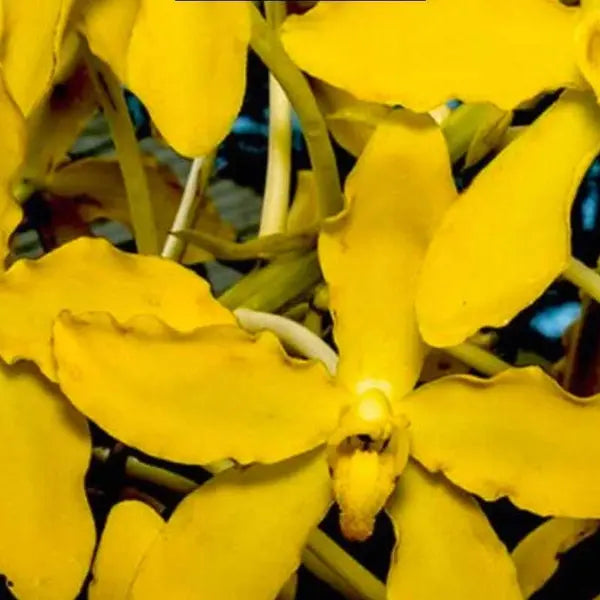
Grammatophyllum Speciosum Var.Alba
Grammatophyllum speciosum var. alba, also known as the "Tiger Orchid" or "Queen of Orchids," is a magnificent and large orchid species.
Here's a comprehensive care guide for Grammatophyllum speciosum var. alba:
1. Light:
Bright, indirect light is crucial. They need abundant light to grow and flower well.
Morning sun is ideal (east-facing window). A south-facing window can also work if you provide some sheer curtain shading from mid-February to late October to prevent sunburn.
If growing outdoors, place them in an area with filtered light, such as under a pine tree or shrub.
Avoid prolonged direct sunlight, as it can scorch the leaves.
Indoors, LEDs can be a good option for artificial light.
Monitor leaf color: Healthy leaves should be a lime-green color. Yellowing leaves can indicate too much light, while very dark green leaves might mean insufficient light.
2. Temperature and Humidity:
Warm temperatures:
Day: 22∘C to 30∘C (72∘F to 85∘F)
Night: A 6∘C (10∘F) drop is beneficial for flower bud initiation and stronger growth, ideally 18∘C to 24∘C (65∘F to 75∘F).
High humidity is essential: Aim for 50% to 70%.
Achieve this with a humidifier, humidity tray (ensure the pot isn't sitting in water), or by misting the surrounding area (not directly on the leaves to avoid bacterial growth, especially in the evening).
Good air circulation is vital with high humidity to prevent fungal issues.
3. Watering:
Frequent and heavy watering during the growing season (typically March to October), especially when spikes are emerging.
Allow the potting medium to approach dryness before re-watering. Grammatophyllum do not like "wet feet" for extended periods, but they also don't like to dry out completely.
Reduce watering slightly during winter months, but don't let the plant dry out completely. Brown, shriveled leaf tips can indicate underwatering.
Pseudobulbs are a good indicator: They should be plump in summer and only slightly shriveled in winter. Increase watering if they start to shrivel significantly.
Water in the morning to allow leaves to dry before night, preventing bacterial growth.
Water quality: Rainwater, distilled water, or reverse osmosis water are preferred due to low alkalinity. Tap water can be used, but you'll need to repot more frequently due to mineral buildup.
4. Fertilization:
Fertilize consistently during the growing season.
A balanced NPK fertilizer (e.g., 20-20-20 or 15-15-15) is generally recommended.
Some growers use a high-phosphorus fertilizer (e.g., 0-52-34) to encourage blooming after a slight dry period.
Apply at half the recommended strength weekly during the active growing season.
Flush with clear, non-softened water once a month to prevent fertilizer salt buildup, as their roots are sensitive to it.
Reduce fertilizer frequency during the dormant period.
5. Potting and Repotting:
Potting Medium: Use a well-draining orchid mix. Good options include:
New Zealand Sphagnum Moss
Medium or large grade orchid bark mix (such as fir bark, charcoal, pumice, or tree fern)
A mix of equally sized particles of four parts coarse coniferous bark, two parts coarse pumice chips, and one part charcoal.
Pot Type: Plastic, clay, or wooden containers with good drainage holes are suitable. Due to their large size, they are often grown in large pots or even wooden slatted baskets.
Repotting: Repot every 1-2 years (if using tap water) or every 2-3 years, typically in the spring, when the potting medium breaks down or new growth appears.
Gently remove the plant from the old pot. If in a clay pot, you might need to break the pot.
Trim off any dead or rotting roots and old, squishy pseudobulbs.
Position the plant with its oldest pseudobulbs towards the edge of the new pot, leaving room for new growth.
Press the new medium firmly around the roots, ensuring the plant is stable. The rhizome should be about half an inch below the rim of the pot.
Grammatophyllum can grow to be enormous, so choose a pot that accommodates their size.
6. Flowering:
Grammatophyllum speciosum are known for their spectacular, large flower spikes that can bear numerous flowers.
They typically bloom once every two to four years, but when they do, the bloom period can last for one to two months, with individual flowers remaining fresh for up to six weeks.
To encourage re-blooming:
Reduce irrigation for about two weeks to create a dry period.
Then, fertilize with a high-phosphorus fertilizer (e.g., 0-52-34) for 3-4 consecutive weeks.
Continue to reduce irrigation for another two weeks after this fertilizer application.
If no spikes appear, resume normal watering and prepare for the next vegetative phase.
7. Pests and Diseases:
Good air circulation and proper watering practices are key to preventing most issues.
Common orchid pests like mealybugs, scale, and spider mites can occur. Inspect your plant regularly and treat promptly with appropriate orchid-safe insecticides if necessary.
Fungal or bacterial infections can arise from overwatering or poor air circulation. Remove affected parts and improve conditions.
Note that older pseudobulbs turning brown and squishy before drying up is a normal process for Grammatophyllum as they drop old growths. This generally doesn't spread to newer pseudobulbs.
Important Considerations:
Grammatophyllum speciosum can grow to be very large, potentially weighing hundreds of kilograms to over a tonne in their natural habitat. While cultivated specimens won't reach these extremes, be prepared for a substantial plant that requires significant space.
They prefer not to be disturbed or moved often.
By following these guidelines, you can provide the best possible care for your Grammatophyllum speciosum var. alba and enjoy its impressive growth and beautiful blooms.

